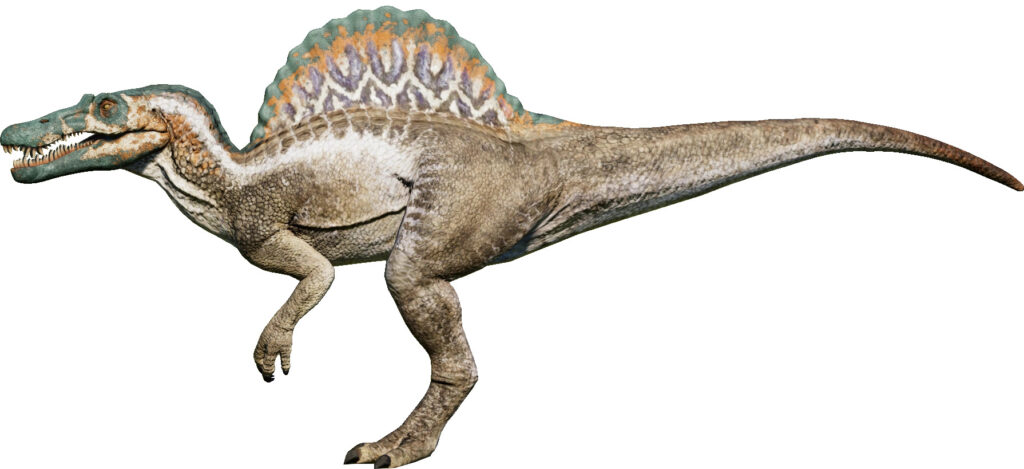Spinosaurus is a genus of theropod dinosaur that lived during the Late Cretaceous period, about 112 to 93.5 million years ago. It was first discovered in Egypt in 1912 by German paleontologist Ernst Stromer. The genus name means “spine lizard,” referring to the distinctive spines that protrude from its back vertebrae.
Spinosaurus is known for its unique physical characteristics, including its long, narrow snout, crocodile-like jaws, and sail-like structure on its back. This sail was likely used for display and thermoregulation, as well as possibly aiding in swimming.
Spinosaurus was also one of the largest carnivorous dinosaurs, with estimates of its length ranging from 12 to 18 meters (39 to 59 feet) and its weight ranging from 7 to 20 tons.
Despite its notoriety, Spinosaurus remains a mysterious dinosaur due to the incomplete fossil record and limited knowledge about its behavior and ecology. However, recent discoveries and advancements in technology have shed new light on this fascinating creature, making it a subject of ongoing research and debate in the paleontological community.
Key Attributes of Spinosaurus

| Name | Spinosaurus |
|---|---|
| Size | Estimated to be 12 to 18 meters (39 to 59 feet) in length |
| Age | Early Cretaceous (approximately 112 to 93 million years ago) |
| Diet | Carnivorous, primarily preying on fish and potentially other aquatic animals |
| Classification | Kingdom: Animalia, Phylum: Chordata, Class: Sauropsida, Superorder: Dinosauria, Order: Saurischia, Suborder: Theropoda, Family: Spinosauridae, Genus: Spinosaurus |
| Habitat | Riparian environments, river systems, and coastal regions |
| Distribution | Found in North Africa, specifically in what is now Morocco, Egypt, and Tunisia |
| Unique Features | Large size, sail-like structure on its back, crocodile-like snout, and conical teeth |
| Behavior | Semi-aquatic lifestyle, likely spent much of its time in or near water |
| Prey | Primarily fish, but potentially also hunted other small to medium-sized dinosaurs |
| Cultural Significance | Known for its distinctive sail and appearances in popular culture, including the movie “Jurassic Park III” |
| Fossil Record | Fossils have been found in North Africa, particularly in the Kem Kem Beds of Morocco |
Physical Characteristics
Size and Weight
Spinosaurus is one of the largest carnivorous dinosaurs ever discovered, with estimates of its length ranging from 12 to 18 meters (39 to 59 feet) and its weight ranging from 4.5 to 20 tons. It was longer than Tyrannosaurus rex and had a more elongated body shape, with a relatively short tail compared to other theropods.
Distinctive Features
Spinosaurus had several distinctive features that set it apart from other dinosaurs. Its most notable feature was the large sail on its back, which was formed by elongated spines that grew from its vertebrae.
The exact function of the sail is still debated, but it may have been used for display, thermoregulation, or both. Spinosaurus also had a long, narrow snout filled with conical teeth, which suggests that it was adapted for catching fish.
Diet and Hunting Methods
Based on its physical characteristics, scientists believe that Spinosaurus was a semi-aquatic predator that hunted fish and other aquatic animals. Its long snout and sharp teeth would have been ideal for catching slippery prey in the water, while its powerful hind limbs would have allowed it to move quickly on land.
Spinosaurus may have also used its sail to help it swim, much like a modern-day sailboat.
Overall, Spinosaurus was a unique and formidable predator that dominated the rivers and lakes of its time. Its distinctive features and adaptations provide valuable insight into the evolution of theropod dinosaurs and the ecosystems in which they lived.
Habitat and Geographic Distribution
Spinosaurus lived during the Late Cretaceous period, around 100-93 million years ago. It is believed to have inhabited the river systems and coastal regions of what is now northern Africa, specifically in what is now Egypt and Morocco.
The discovery of Spinosaurus fossils in these regions suggests that it was adapted to a semi-aquatic lifestyle, spending much of its time in and around water. This is supported by the shape of its skull and teeth, which were well-suited for catching fish.
In addition to its aquatic habitat, Spinosaurus likely also lived in forested and swampy environments, as evidenced by the presence of fossils of other dinosaurs and prehistoric creatures found in the same regions.
While Spinosaurus is primarily associated with northern Africa, it is possible that it may have also lived in other parts of the world, as some similar species have been found in South America and Europe. However, more research is needed to confirm this.
Overall, Spinosaurus had a diverse range of habitats and likely lived in a variety of environments, making it a fascinating and adaptable species to study.
Historical Discovery
First Fossil Discoveries
The first Spinosaurus fossil was discovered in the early 20th century by German paleontologist Ernst Stromer. The fossils were found in Egypt’s Bahariya Oasis in 1912, and included a partial skull, vertebrae, and limb bones. Stromer named the new species Spinosaurus aegyptiacus, meaning “Egyptian spine lizard.”
Unfortunately, the fossils were destroyed in a bombing raid during World War II, leaving only Stromer’s notes, drawings, and photographs as evidence of the original discovery. It wasn’t until nearly a century later that new Spinosaurus fossils were found and studied in detail.
Recent Discoveries
In 2014, a team of researchers led by Nizar Ibrahim discovered a new Spinosaurus specimen in the Kem Kem Beds of Morocco. This specimen included a nearly complete skeleton, allowing scientists to learn much more about the anatomy and behavior of this unique dinosaur.
One of the most surprising findings was that Spinosaurus was adapted to an aquatic lifestyle, with paddle-like feet and a long, crocodile-like snout. This discovery challenged the long-held view of Spinosaurus as a primarily land-dwelling predator.
Since then, several more Spinosaurus specimens have been found in Morocco, including a juvenile individual that sheds light on the development and growth of these dinosaurs. Each new discovery adds to our understanding of this fascinating creature and its place in the dinosaur family tree.
Spinosaurus in Popular Culture
Spinosaurus has made appearances in various forms of popular culture, including movies, video games, and literature. Here are some notable examples:
Movies

Spinosaurus made its big-screen debut in the 2001 film “Jurassic Park III.” In the movie, a Spinosaurus is shown to be larger and more powerful than the T. rex, which was the main antagonist in the previous two “Jurassic Park” films.
Video Games
Spinosaurus has appeared in numerous video games, including the “Jurassic Park” franchise. In the game “Jurassic World Evolution,” players can create their own Spinosaurus and add it to their dinosaur park.
Literature
Spinosaurus has been featured in various works of fiction, including the novel “Raptor Red” by Robert T. Bakker. In the book, a Spinosaurus is one of the main predators that the protagonist, a Utahraptor named Raptor Red, must avoid.
Overall, Spinosaurus has become a popular dinosaur in pop culture due to its unique appearance and impressive size.
Controversies and Debates
Bipedal or Quadrupedal
One of the main controversies surrounding Spinosaurus concerns its posture. While some scientists believe that Spinosaurus was bipedal, others claim that it was quadrupedal. Those who argue for a bipedal posture point to the long, slender hindlimbs of Spinosaurus, which they claim were adapted for walking on two legs.
They also argue that Spinosaurus had a center of mass that was shifted forward, which would have made it easier for the dinosaur to balance on its hindlimbs.
Those who argue for a quadrupedal posture, on the other hand, point to the large and powerful forelimbs of Spinosaurus. They argue that these limbs were better adapted for supporting the weight of the dinosaur, and that Spinosaurus would have had a hard time balancing on two legs.
They also point to the fact that Spinosaurus had a long, heavy tail, which would have made it difficult for the dinosaur to maintain balance while walking on two legs.
Aquatic or Semi-Aquatic
Another area of debate concerns the environment in which Spinosaurus lived. While some scientists believe that Spinosaurus was a fully aquatic dinosaur, others argue that it was only semi-aquatic. Those who argue for a fully aquatic lifestyle point to the long, narrow snout of Spinosaurus, which they claim was adapted for catching fish.

They also point to the fact that Spinosaurus had a number of adaptations that would have allowed it to swim, such as webbed feet and a streamlined body.
Those who argue for a semi-aquatic lifestyle, on the other hand, point to the fact that Spinosaurus still had some adaptations for life on land, such as its large and powerful hindlimbs. They also argue that Spinosaurus would have had a hard time hunting on land if it spent most of its time in the water.
Some scientists have suggested that Spinosaurus was a “swamp-dweller,” spending most of its time in shallow water or on the banks of rivers and lakes.
Frequently Asked Questions
What is the scientific name for Spinosaurus?
The scientific name for Spinosaurus is Spinosaurus aegyptiacus. It is a genus of theropod dinosaur that lived in what is now North Africa during the Cretaceous period, about 112 to 97 million years ago.
Where was Spinosaurus discovered?
The first fossils of Spinosaurus were discovered in Egypt in 1912 by German paleontologist Ernst Stromer. However, these fossils were destroyed during World War II. In recent years, new fossils have been discovered in Morocco and other parts of North Africa.
What were Spinosaurus’ enemies?
Spinosaurus lived in a region that was home to many other large predators, such as Carcharodontosaurus and Sarcosuchus. However, Spinosaurus was likely the top predator in its ecosystem and did not have any natural enemies.
Is Spinosaurus more powerful than T-Rex?
Spinosaurus and T-Rex lived in different time periods and ecosystems, so it is difficult to compare them directly. However, Spinosaurus was larger than T-Rex and had a long, crocodile-like snout that was adapted for catching fish. Spinosaurus also had powerful arms with large claws that could have been used for hunting or defense.
What led to the extinction of Spinosaurus?
The exact cause of Spinosaurus’ extinction is not known, but it is believed to have been part of a larger extinction event that wiped out many species at the end of the Cretaceous period. Climate change, volcanic activity, and asteroid impact are all possible factors.
Which dinosaur was larger than Spinosaurus?
There were several dinosaurs that were larger than Spinosaurus, including Argentinosaurus, Patagotitan, and Puertasaurus. These dinosaurs were all long-necked sauropods that lived in the late Cretaceous period.
